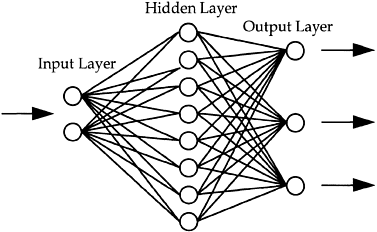313.
| [Cover] [Contents] [Index] |
Page 80

Figure 2.10 A multilayer perceptron neural network composed of three layers, which contain two input neurones, eight hidden neurones and three output neurones, respectively.
more complex mathematical operation may be chosen for a particular need in place of the summation operator.
ANNs also differ in terms of learning strategy and neurone characteristics. A learning strategy specifies an initial set of weights and indicates how these weights and the neurone values should be updated in order to improve performance. The goals of simplifying the design procedure and optimising learning strategies have attracted the attention of many researchers.
ANNs generally provide some degree of robustness and fault tolerance because there are many processing neurones within an ANN, each with its own local linking neighbours. As a result, damage to a few elements or links will generally not cause a serious impact on overall performance. Most ANNs also use adaptive connection weights to improve performance based on current results. Adaptation also serves a degree of robustness by compensating for minor variability in the characteristics of the input data. ANNs also make weaker assumptions concerning the nature of the individual class frequency distributions than do the traditional statistical classifiers such as those described above. Such a property could be advantageous in dealing with non-Gaussian data, for example, or categorical data such as soil types.
Since the early studies of ANNs by McCulloch and Pitts (1943), Hebb (1949), Rosenblatt (1959), and Widrow and Hoff (1960), a variety of neural network structures and learning algorithms have been developed. These neural network topologies are designed to operate in either supervised or unsupervised modes. Knowing the specific properties of each kind of neural network classifier can optimise the network’s performance, for example by
| [Cover] [Contents] [Index] |
EAN: 2147483647
Pages: 354